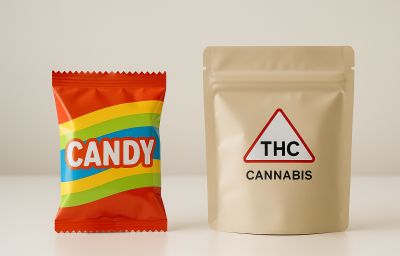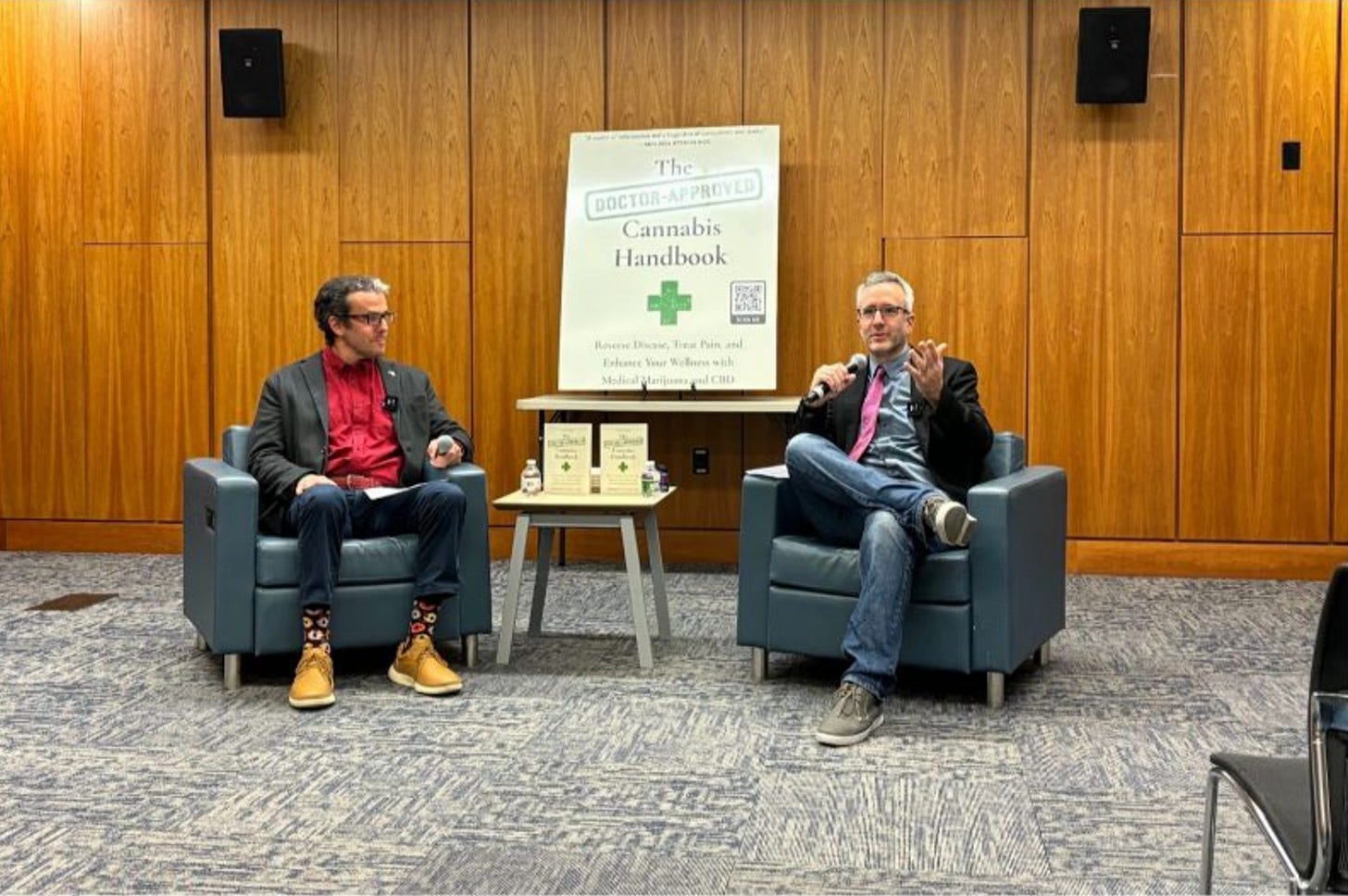Table of Contents
- Every Halloween, the Same Scare: The Truth About Cannabis-Laced Candy
- When Candy and Cannabis Look the Same
- How to Tell the Difference: A Parent’s Visual Guide
- How Parents Can Prevent Mix-Ups
- What to Do If a Child Eats a Cannabis Edible
- The Real Risk: Stigma and Storage, Not Strangers
- Building a Smarter Halloween Conversation
- Halloween, Cannabis, and Common Sense: Summary Thoughts
Every Halloween, the Same Scare: The Truth About Cannabis-Laced Candy
Each Halloween, the same story stalks across headlines like a ghost that won’t rest: “Parents, beware of cannabis-laced candy!” The panic rises, peaks, and fades, rumor, reaction, reassurance, and twelve months later, it returns again.
Agencies like the DEA issue annual warnings, sometimes even formal press releases, such as the one in 2018 that rippled through national news. A year later, it was a local story out of Florida claiming an “uptick” in THC-related illnesses. Before that, it was apples laced with razors, needles in chocolate bars, or pills posing as sweets. Different props, same fear.
Major outlets including The Washington Post and The New York Times have traced this ritual of worry for decades. Entire Wikipedia pages now catalog the mythmaking history of “poisoned candy,” a kind of cultural folklore disguised as public safety.
But something has changed. As legalization expands, cannabis products have become far more visible in everyday life. In fact, a national poll found that 58% of Americans now believe cannabis is a healthier option than alcohol, and a majority expect full national legalization within five years (Marijuana Moment, 2025).
At the same time, NPR reported in 2024 that more Americans now use cannabis more often than alcohol, a major behavioral shift that underscores how normalized cannabis has become in adult life. That normalization brings new challenges, especially for parents of young children.
Because when you pause to think about it, the central claim of the Halloween panic begins to crumble.
Who are these imagined villains buying expensive, regulated cannabis products, risking arrest, simply to frighten children for fun? What would that even accomplish?
The fear persists not because it’s true, but because it’s familiar. And familiarity, especially when tied to fear, can be hard to outgrow. What we’re really confronting each October isn’t a wave of malice. It’s a wave of misunderstanding.
What The Data Show
✅ The U.S. Drug Enforcement Administration (DEA) has never confirmed a single case of strangers distributing cannabis-infused candy to children.
✅ Children’s Hospital Colorado reported that 100% of pediatric cannabis exposures treated in 2023 occurred at home, not from Halloween events.
✅ The American Association of Poison Control Centers notes that most cannabis ingestion calls involve edibles mistaken for food left unsecured in households.
✅ The Journal of the American Medical Association (JAMA) found that pediatric cannabis exposures in legalized states correlate with household access, not community distribution.
✅ The National Safety Council ranks accidental THC ingestion well below common childhood hazards like detergent pods, batteries, or medications.
When Candy and Cannabis Look the Same
One October evening in Massachusetts, a father sat at his kitchen table helping his daughter sort through a mountain of Halloween candy. Amid the crinkled wrappers and melted chocolate, he noticed a small resealable pouch marked “THC.” It wasn’t from trick-or-treating. It was his. Left out by mistake.
That’s the real story. Not strangers, but storage.
As cannabis becomes part of normal adult life, the line between candy and cannabis sometimes blurs in appearance, not intent. Gummies, chocolates, and mints share the same cheerful colors and glossy wrappers as ordinary sweets. For parents scanning baskets under dim porch lights, confusion is understandable. But confusion doesn’t mean catastrophe.
It means we need literacy, not panic.
Most parents don’t realize that regulated cannabis products follow strict labeling and design laws precisely to prevent this confusion. These rules make adult products look intentionally plain, functional, and unappealing to children.
In Missouri, for instance, cannabis packages may use only one color, display no more than two logos, and must feature the word “Marijuana” prominently on the front. Massachusetts and Illinois have similar regulations, along with child-resistant, resealable packaging, something no candy manufacturer uses.
simple way to remember:
Tears open easily? Candy.
Clicks or zips closed? Cannabis.
Unregulated or counterfeit edibles are a different story. Products with playful names like Trips Ahoy, Stoney Patch Kids, or Skitttllez are not legal cannabis, they’re knockoffs, sold outside dispensaries and often without testing or labeling. For parents, that distinction matters.
The real risk isn’t a stranger across the street. It’s a product in the pantry that looks too much like candy.
Knowing what adult-use cannabis edibles look like helps families store them safely, recognize them quickly, and focus on what Halloween is supposed to be: fun, not fear.
🗣️ “Education protects children far better than fear ever will.”
What the Data Show About Packaging and Safety
📍 In Colorado, every documented pediatric cannabis exposure occurred at home, not from trick-or-treating strangers. (Wang GS et al., Pediatrics 2016)
📍 JAMA Pediatrics research confirms that child-resistant packaging and caregiver education are the key predictors of prevention. (Onders B et al., 2019)
📍 State regulations in Massachusetts (935 CMR 500.105), Missouri (19 CSR 100-1.140), and Illinois (410 ILCS 705/55-21) require packaging to be plain, resealable, child-resistant, and labeled with the word “Marijuana” and a universal THC symbol.
📍 Cost alone discourages tampering: regulated edibles typically sell for $2–$4 each, versus $0.10–$0.25 for ordinary candy, a ten- to twenty-fold difference.
📍 The simplest safeguard remains: If it reseals, read the label, then lock it up.
How to Tell the Difference: A Parent’s Visual Guide
Sorting through a mountain of Halloween candy under soft porch light can feel like a guessing game. But spotting cannabis edibles isn’t difficult once you know what to look for. You don’t need special equipment, just a few seconds of informed attention.
This is the simple, science-backed checklist that public health educators and pediatricians recommend to help parents tell the difference between ordinary candy and cannabis-laced candy.
1. The Package Test: Resealable = Red Flag
Candy wrappers are single-use. They tear, twist, or crinkle and can’t be resealed.
Cannabis edibles, by contrast, come in resealable, child-resistant pouches or containers, often with zip-tops, snap locks, or press-and-turn caps.
If it closes again, it’s not candy.
If it looks like candy but reseals, set it aside and check the label.
💡 Quick rule: If it’s easy for a child to open, it’s safe for a child to eat. If it isn’t, it’s probably not candy.
2. The Label Test: Words Matter
Every licensed cannabis edible must display:
- The word “Marijuana” or “THC.”
- A THC warning symbol, often a red or yellow triangle.
- A dosage statement, like “10 mg THC per piece.”
If you don’t see those, it’s candy.
If you do, it’s not for kids.
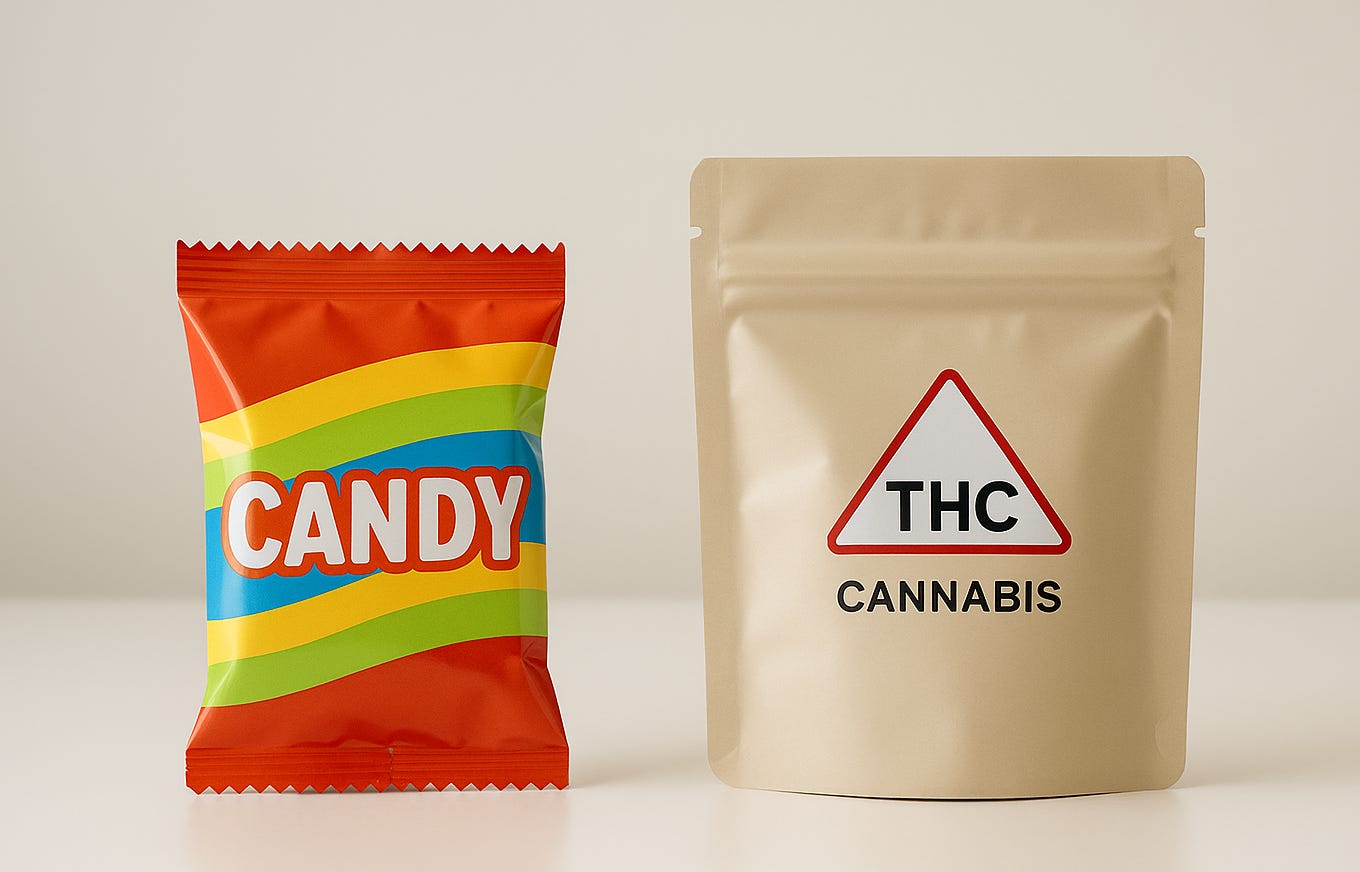
3. The Design Test: Plain vs. Playful
Cannabis edibles are designed to look boring.
Regulations require simple packaging, one color, minimal logos, no mascots, no glitter.
Candy, on the other hand, practically screams for attention: bright fonts, cartoon characters, sparkles, and foil.
🎃 Pro tip: If the design looks dull, it’s probably an edible. If it looks like a carnival, it’s candy.
4. The Texture Test: Uniform = Unlikely Candy
Cannabis edibles are made in precise, uniform batches for dosing accuracy.
Every piece looks identical in shape, size, and color.
Candy, by contrast, varies, some pieces melt, some stick, some break.
Real candy is chaotic.
Cannabis is consistent.
5. The Smell Test: Subtle but Distinct
Most modern edibles are nearly odorless, but some carry a faint herbal, earthy, or resinous scent rather than a sugary or fruity one.
If it smells like plants instead of pastries, treat it cautiously.
The Quick Check Rule
Look. Read. Secure.
If it reseals, read the label.
If it says “THC,” store it safely.
Three seconds of attention prevent hours of worry
🧠 Keep in Mind:
“Confusion isn’t dangerous. Complacency is. Once you know what to look for, Halloween stays sweet for everyone.”
Evidence That Supports the Visual Checklist
🔎 Between 2017 and 2021, edible cannabis exposures in children under 6 increased, as recorded by the National Poison Data System, though most cases resulted in mild or moderate symptoms and required outpatient observation (Pediatrics, 2023).
🔎 Pharmacologic data suggest that ingesting 10 mg THC in a young child generally does not lead to severe toxicity; however, as dose increases relative to weight, the probability of prolonged or severe symptoms also rises (Pediatrics, 2024).
🔎 Toxicology experts and the American College of Medical Toxicology endorse child-resistant packaging, plain labeling, and advertising restrictions as key measures to reduce accidental ingestion risk (ACMT Pediatric Cannabis Exposure Position Statement, 2022).
🔎 Reports of Δ⁸-THC exposures are rising, with one study showing approximately a 79 % increase in poison control calls from 2021 to 2022, reflecting evolving product landscapes parents must monitor (Journal of Medical Toxicology, 2024).
🔎 Clinical reviews note that pediatric ingestion presentations vary widely, making early visual assessment and prompt evaluation essential in ambiguous cases (Pediatric Emergency Care, 2024).
How Parents Can Prevent Mix-Ups
Once you know how to recognize cannabis edibles, the next step is easy: prevent confusion before it happens.
Nearly all accidental ingestions occur at home, not on Halloween night. The solution isn’t fear, it’s forethought.
Parents don’t need new rules, just sharper habits.
The goal is the same as with any medication: safety without stigma.
1. Store Cannabis Separately
Keep cannabis products in a locked or elevated cabinet, away from snacks, desserts, and candy.
Opaque containers help, since bright colors can tempt curious hands.
Think of this as the “double-door rule”:
One door for food, another, locked, for medicine or cannabis.
💡 Pro Tip: Use a small luggage lock or coded lockbox for added safety. Hide it as well as you lock it.
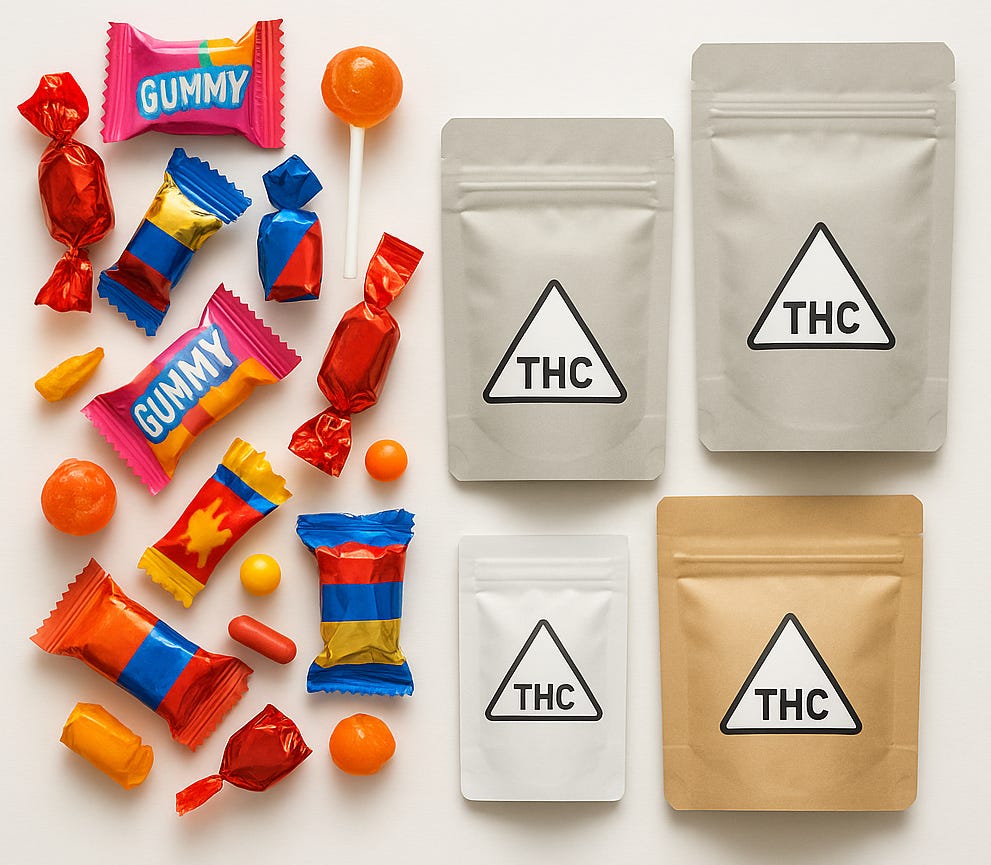
2. Label Clearly, Even at Home
If you repackage or make your own edibles, mark them clearly:
“Contains THC. For adult use only.”
A simple label can prevent panic later.
Whenever possible, keep edibles in their original packaging, it’s designed with child-resistant seals and warning symbols for a reason.
3. Keep Edibles Away from Halloween Candy
In the week leading up to Halloween, physically separate your candy stash from cannabis products.
Many incidents happen during post-party cleanup or late-night sorting, when both types of sweets end up on the same counter.
Separate them now. Save yourself a crisis later.
Two seconds of attention prevents hours of regret.
4. Educate, Don’t Scare
Children respond better to honesty than fear.
A calm, age-appropriate explanation:
“These are adult products that can make your body feel strange if you eat them”, is usually enough.
For teens, talk about cannabis like you would alcohol or prescription medication:
not forbidden, but not for kids.
✅ Research shows that open, nonjudgmental communication lowers risky behavior and builds long-term trust between parents and children.
🗣️ Simple Truth: “Fear fades. Honesty lasts.”
5. Have a Plan, Just in Case
Save the Poison Control Hotline: 800-222-1222
Post it on your fridge, store it in your phone, and make sure babysitters, grandparents, or older siblings know it too.
Preparation doesn’t mean expecting a problem, it means knowing how to handle one calmly.
Parental Quick-Checklist
☑️ Lock up adult-use products
☑️ Label homemade edibles
☑️ Separate candy and cannabis
☑️ Educate without fear (see this video I made on the topic)
☑️ Keep Poison Control visible
Small habits create large safety margins.
And that’s what turns concern into confidence.
Why Prevention Works: What the Data Tell Us
The habits that protect children from cannabis mix-ups aren’t guesswork. They’re backed by evidence.
⛳ Between 2017 and 2021, U.S. poison control centers documented a sharp rise in edible cannabis exposures among children under six, but nearly all cases were mild or moderate and resolved with observation (Pediatrics, 2023).
⛳ Analyses show that most exposures occur when edibles are left accessible on countertops or in unlocked drawers, not because of supervision failure, but because of poor storage (ACMT Pediatric Cannabis Exposure Position Statement, 2022).
⛳ National poison control data indicate that serious medical outcomes are rare, typically under 2 percent, and that hospitalization rates continue to fall as packaging laws and parental education improve (AAPCC Annual Report, 2023; Pediatric Emergency Care, 2024).
⛳ Surveys from the University of Michigan’s C.S. Mott Children’s Hospital show that parents who openly discuss cannabis safety with their children are more likely to store products securely (Mott Poll, 2024).
⛳ CDC analyses confirm that accidental ingestions tend to occur in homes where products are not securely stored or where caregivers were unaware of their presence (MMWR, 2023).
Together, these findings outline a simple truth:
When adults combine honest communication with secure storage, pediatric cannabis exposures drop dramatically.
That’s not a scare tactic, it’s science.
What to Do If a Child Eats a Cannabis Edible
Even careful families can have close calls. A forgotten pouch, a mislabeled tin, or a momentary distraction can lead to a curious child eating something they shouldn’t. When that happens, the key is calm, informed action, not panic or shame.
Clinical data show that most pediatric THC ingestions cause only temporary symptoms like drowsiness, dizziness, or mild disorientation. Serious or lasting harm is exceedingly rare when the situation is handled promptly and appropriately.
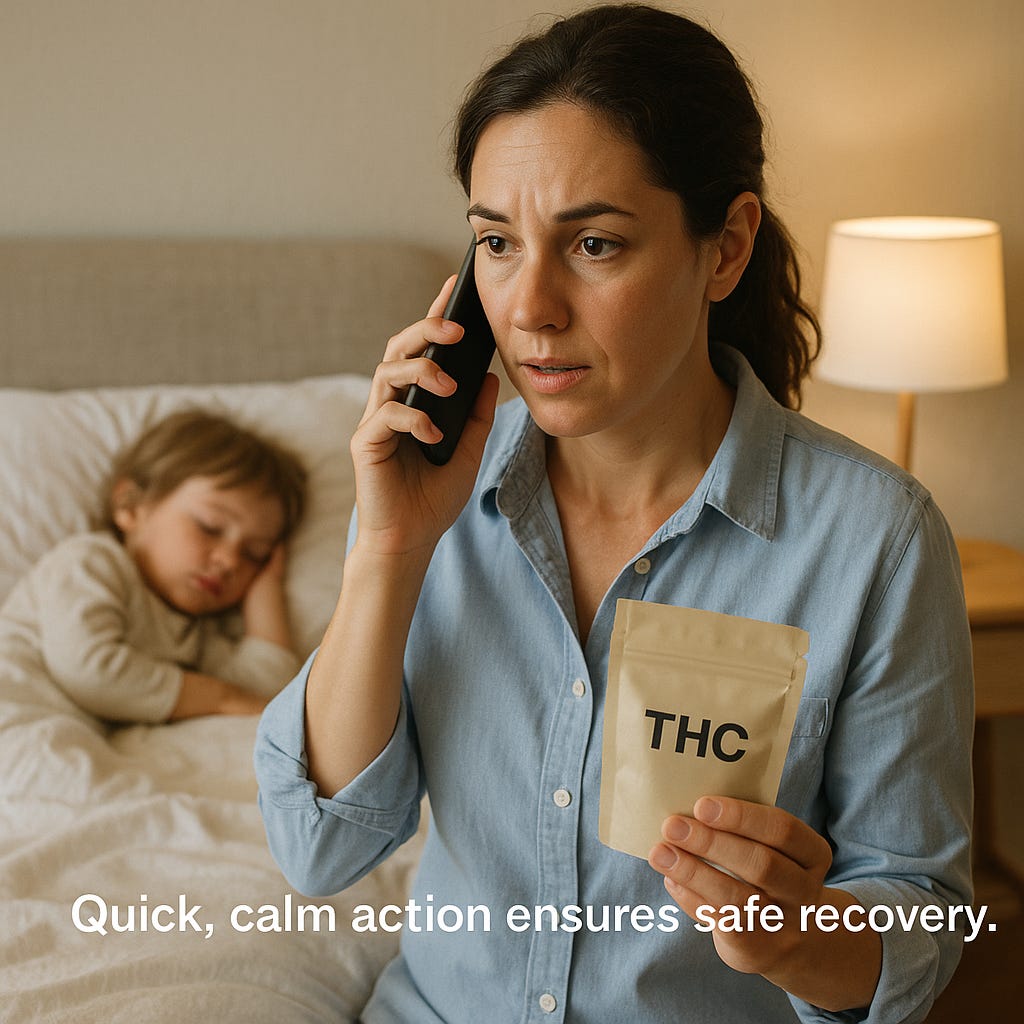
1. Call Poison Control Immediately
📞 Poison Control Hotline (U.S.): 800-222-1222
Specialists are available 24 hours a day to help determine whether observation at home is sufficient or if a hospital visit is necessary.
Have this information ready:
- The child’s age and weight
- The product’s name or package (if available)
- The estimated amount eaten and when it occurred
If the child is difficult to wake, vomits repeatedly, or has slowed breathing, call 911 right away.
💬 “Poison Control is not there to judge, it’s there to help.”
2. Stay With the Child and Observe
Keep your child in a quiet, softly lit space. Avoid bright lights, screens, or noise.
Do not try to induce vomiting, which can worsen confusion or dehydration.
Medical teams typically monitor heart rate, oxygen, and alertness for 6–12 hours until symptoms resolve naturally.
🩺 Most children recover fully with rest and hydration.
3. Bring the Package or Label
If you visit a clinic or emergency room, bring the packaging or container.
The THC strength and serving size help clinicians calculate the likely duration and intensity of effects.
If the edible was homemade, describe what ingredients were used and how much was eaten as accurately as possible.
4. Be Honest with Healthcare Providers
Transparency saves time and prevents unnecessary tests.
Doctors are not required to report accidental cannabis exposures as abuse when they occur in legal households and are reported promptly.
Your honesty helps your care team treat your child faster and more effectively.
5. Learn, Adjust, and Prevent Future Incidents
Once the crisis has passed, treat it as a learning moment, not a failure.
Store edibles in locked or high cabinets.
Keep products in original packaging.
Make sure all caregivers, babysitters, grandparents, neighbors, know where cannabis is stored and how to respond if a child ever gets into it.
🗣️ “Calm action protects children far more effectively than panic ever will.”
The Real Risk: Stigma and Storage, Not Strangers
Every October, the same story makes its rounds.
Headlines warn of “THC candy in your neighborhood!”
Local news anchors clutch props, police departments post infographics, and parents brace for the worst.
It’s an easy story to tell, and an even easier one to believe.
But in all these years, no verified case has ever shown strangers handing cannabis edibles to children on Halloween. Not one.
So what’s really happening?
A quieter, more fixable problem: stigma and storage.
1. The Stranger Myth
The idea that someone would spend real money on regulated cannabis products, risk criminal charges, and hand them to random kids for amusement is both implausible and unsupported by evidence.
Public health agencies and law enforcement across the country have confirmed it year after year: there are zero documented cases of random cannabis-laced candy distribution during Halloween.
What does exist are isolated misunderstandings, a teacher in Buffalo who accidentally shared THC gummies, an Illinois investigation involving mislabeled chocolate, a candy recall in the Netherlands due to contamination. None of these involved malicious intent or strangers targeting children.
Sociologists and myth researchers have tracked these “Halloween poisoning” panics for decades. Most turn out to be the same thing: rumor amplified by repetition.
💬 Fear sells better than facts. It plays to nostalgia, morality, and the illusion that modern dangers lurk just beyond the doorstep.
2. Why the Myth Persists
Fear is a comfortable emotion. It gives us something to do, someone to blame.
Blaming “the stranger” feels safer than facing the truth that most risks live inside our own homes.
The “THC candy scare” isn’t about evil intentions; it’s about our discomfort adjusting to a world where cannabis is normal. For generations, cannabis was hidden, stigmatized, and criminalized. Now it’s a household item, and that cultural shift can be unsettling.
It’s easier to picture a shadowy neighbor with a sinister motive than to say, “Maybe I should buy a lockbox.”
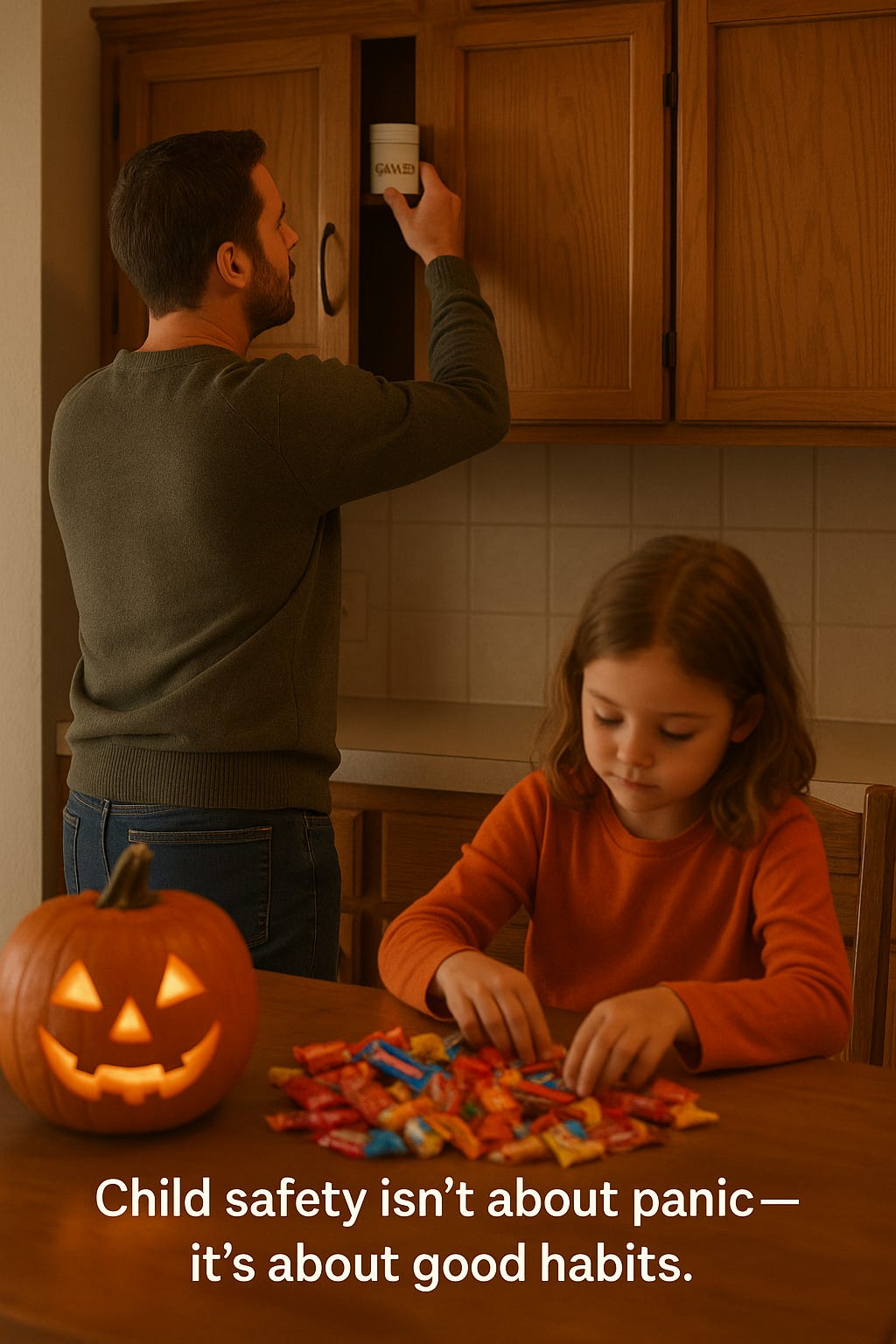
3. The Real Problem: Access at Home
This is where the data points.
Most pediatric cannabis exposures happen in kitchens, backpacks, nightstands, and cars, not in trick-or-treat bags.
Children are curious. Edibles are designed to look friendly.
These are accidents of access, not acts of malice.
And they are entirely preventable.
Lockboxes, opaque containers, and clear labeling save more lives than fear campaigns ever could.
🗣️ “The conversation needs to shift from ‘What if?’ to ‘How do we store this responsibly?’”
4. The Hidden Risk: Stigma
Stigma is the invisible hazard.
It keeps parents quiet. It keeps doctors in the dark.
Many adults who use cannabis responsibly feel uncomfortable mentioning it to pediatricians or family members, worried they’ll be judged. That silence allows small mistakes to go unaddressed and important safety conversations to go unspoken.
Responsible use depends on normalization, not secrecy.
We already talk about alcohol, prescriptions, and cleaning supplies without moral panic. Cannabis should be no different.
5. The Public Health Lesson
The Halloween “THC candy scare” has never really been about candy.
It’s about communication.
When adults share accurate, practical information, children are safer.
When communities replace stigma with education, families thrive.
Fear closes minds. Education opens them.
And the real magic of Halloween is seeing what happens when light meets darkness, and the shadows disappear.
Building a Smarter Halloween Conversation
It’s time to move beyond the myth. Each year, sensational headlines spark anxiety, but panic has never prevented a single ingestion. Education has.
The smartest path forward is a shared one. Parents, schools, clinicians, dispensaries, and regulators each have a role to play in making Halloween safer, and saner, for everyone.
1. Parents and Caregivers: Normalize Safety
Parents set the tone for how children understand risk.
Lock up cannabis products.
Check candy with calm confidence.
Talk honestly about what makes adult products different.
Keep it simple. A short, factual, age-appropriate explanation, clear, not fearful, builds lifelong trust.
💬 “These are for adults, and they can make your body feel strange if you eat them.”
That’s enough for a child.
And for teens, the message is about responsibility, not rebellion. Discuss cannabis the same way you discuss alcohol or medication: with honesty and respect for boundaries.
Public health research confirms what every good parent already knows: open communication protects kids better than silence ever will.
🗣️ “Fear fades. Trust lasts.”
2. Schools and Communities: Focus on Facts
Schools and local organizations shape how families respond to fear.
Instead of forwarding viral warnings, they can share verified safety information about storage, labeling, and emergency response.
Some communities now host safe candy check events or cannabis awareness nights, simple, practical ways to replace rumor with reassurance.
When trusted voices share calm, evidence-based guidance, misinformation loses its grip.
📚 “Facts protect families better than fear ever could.”
3. Clinicians: Keep the Dialogue Open
For healthcare professionals, one question can change everything:
“Do you keep any cannabis products at home?”
Asked neutrally and without judgment, it opens the door for honest dialogue.
Most parents who use cannabis want to use it responsibly, they just need to know it’s safe to ask for guidance.
💬 “As clinicians, our role is to meet people where they are, not where stigma says they should be.”
Every open conversation replaces a wall of shame with a bridge of trust.
4. Regulators and Retailers: Make Safety Obvious
Policy makers and dispensary owners share responsibility too.
Uniform packaging laws and clearly visible THC warning symbols make cannabis products easier for everyone to identify, and harder to mistake for candy.
Public health thrives when industry, government, and medicine speak the same language.
When regulations emphasize clarity over complexity, safety becomes intuitive, not effortful.
🏷️ “The more predictable packaging becomes, the less likely it is to be confused.”
The Collective Shift
When parents model calm, schools promote facts, clinicians guide without judgment, and regulators uphold transparency, the “THC candy panic” finally loses its audience.
What’s left is what Halloween should have been all along: a night of joy, laughter, and connection, where safety is simple and fear has no stage time.
💬 “When communities trade panic for partnership, children thrive.”
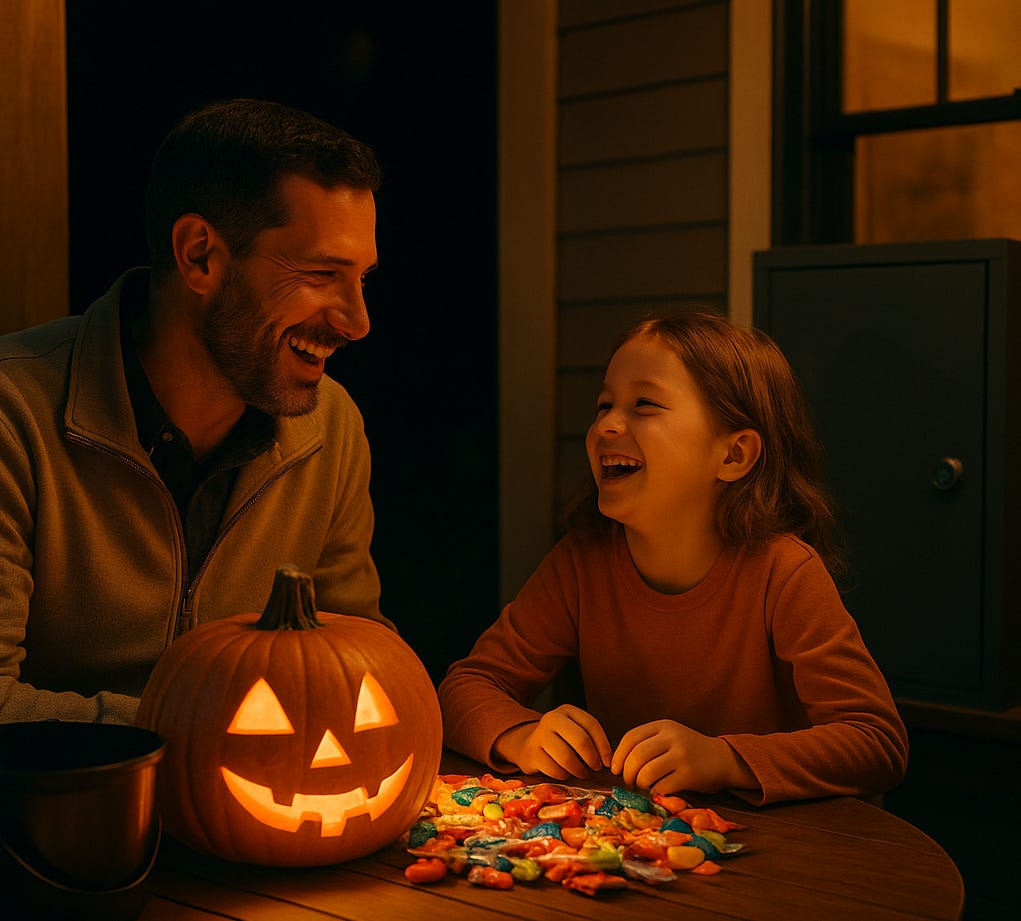
Halloween, Cannabis, and Common Sense: Summary Thoughts
Halloween was never meant to be a night of anxiety. It’s a celebration of imagination, community, and childhood joy. Yet every October, the same fear resurfaces like fog across front lawns: the whisper that danger waits inside the candy bowl.
The truth is far simpler, and far less frightening.
There is no epidemic of tainted candy.
There is no wave of strangers handing out THC gummies.
There never has been.
What we are living through instead is a new era of shared responsibility. Cannabis now exists in more homes than ever before. That reality calls for awareness, not alarm.
Safety doesn’t come from suspicion. It comes from systems.
Lock it up. Label it clearly. Educate without fear.
When adults model calm, informed behavior, children learn from it. They see that responsibility isn’t rooted in fear, but in respect, for their safety, for our tools, and for the truth. The result isn’t only safer homes, but stronger, more trusting families.
🗣️ “Fear doesn’t protect children. Informed adults do.”
The Takeaway
Enjoy Halloween.
Let kids be kids.
Let adults be responsible.
And let common sense bridge the space between the two.
When the porch lights fade and the candy buckets overflow, remember this:
Good medicine, good parenting, and good citizenship all rest on the same foundation, trust, truth, and care.
💬 “In medicine, fear rarely heals. Knowledge does. Halloween shouldn’t be a cautionary tale; it should be a celebration of how far our understanding has come.” – Dr. Benjamin Caplan
Empty the Bowl Into Your Bag: What This All Means
◆ There is no evidence of strangers distributing THC-laced candy to children.
◆ Most pediatric exposures happen at home due to improper storage, not malice.
◆ Safe storage, clear labeling, and honest communication prevent almost every incident.
◆ Stigma fuels silence, and silence increases risk.
◆ When parents, schools, clinicians, and policymakers cooperate, safety becomes simple.
◆ The real power lies in education, empathy, and partnership, not panic.
🍬 “When we replace panic with prevention, we turn fear into public health.”
Resources
- Poison Control Hotline: 800-222-1222
- CDC Cannabis Health & Safety: cdc.gov/marijuana
- CED Clinic Cannabis Encyclopedic FAQ
- CED Clinic Medical Cannabis Learning Lab
- Clinical Fellowship at CED Clinic
- Learn from CED Clinic: Education at CED
- Read on Amazon: The Doctor Approved Cannabis Handbook
Join the Movement!
If this guide helped you feel more confident this Halloween, share it with another parent, teacher, or clinician who might need the same calm clarity.
🔗 Share this post to help others learn to replace panic with prevention, and help friends trade fear for facts, and myths for mindfulness.
🗨️ Leave a comment: How are you teaching your kids about adult products this Halloween?
📬 Subscribe: For more doctor-approved insights on cannabis, health, and responsible public education, subscribe to my newsletter
🫱 Stay Connected
For more evidence-based insights on cannabis and public health?
Follow for daily updates, patient stories, and clinical education:
🌿 Instagram: @DrBenjaminCaplan
💬 X: @DrCaplan
🕺 TikTok: @DrBenjaminCaplan
💼 LinkedIn: Benjamin Caplan, MD
📺 YouTube Shorts: 2 min or less w/ Dr. Caplan
Join the community that’s replacing panic with prevention, one fact at a time.

